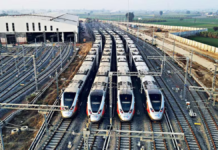PATNA (Metro Rail News): As part of its commitment to sustainable and renewable energy sources, one of the primary goals of the Patna Metro project is to bridge the power gap in the city and reduce the carbon footprint of the transportation system. To achieve this goal, the Patna Metro system is expected to be equipped with solar power panels, similar to the Delhi Metro model.
The decision comes as a result of DMRC’s commitment to Patna Metro Project in reducing carbon footprint and to assist in uninterrupted power supply to its stations in the future. Considering the futuristic technology and potential for solar power generation, it will implement rooftop grid connected solar power panels at selected locations of elevated stations and maintenance depots. The solar panels installed on the rooftops of the metro stations will generate clean and green energy, which will aid constant power supply at Patna Metro stations.
The solar panels will generate approximately 6.5 megawatts of electricity per day. Different sheds and buildings of the establishment are proposed to be used for Solar Photovoltaic (SPV) installation to optimize the solar energy potential. The requirement of power at each elevated station is expected to be 200kW-300kW and 1500kW-2000kW for each underground station. The generated solar power can be used for auxiliary services at the stations like lift operation, lighting, signalling and telecommunication, firefighting system, fare collection system etc.
This initiative for Patna Metro will not only reduce the reliance on non-renewable sources of energy, but it is also in line with the Indian Government’s target of achieving 50 percent cumulative electric power from renewable resources by 2030 and achieve net-zero carbon emissions by 2070. This initiative is also in line with the measures suggested by Bihar Renewable Energy Development Agency (BREDA) towards adopting sustainable construction practices.
Patna Metro is committed to providing clean and green transportation solutions to the citizens of Patna. By adopting solar energy, it is not only reducing carbon footprint but also contributing to the development of a sustainable future. With this initiative, it will set an example for other transport systems to follow.






